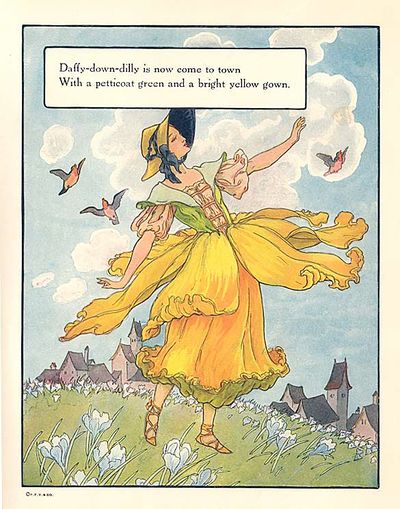Annotation:Mistake (1) (The): Difference between revisions
No edit summary |
No edit summary |
||
| Line 2: | Line 2: | ||
---- | ---- | ||
<p><font face="garamond, serif" size="4"> | <p><font face="garamond, serif" size="4"> | ||
'''MISTAKE [1], THE'''. AKA and see "[[Daffeedowndilly (The) | '''MISTAKE [1], THE'''. AKA and see "[[Daffeedowndilly (The)]]." English, Jig. G Major. Standard tuning (fiddle). AABB. The melody was first printed in one of Walsh's volumes, and in David Rutherford’s '''Compleat Collection of 200 of the Most Celebrated Country Dances''' (London, 1756). Manuscript versions appear in the commonplace book of Cheapside, London, musician Walter Rainstorp (begun 1747), and the manuscript collection of Northumbrian musician William Vickers, started in 1770. Regarding the alternate title, there is an old nursery rhyme that goes:[[File:daffydown.jpg|400px|thumb|right|]] | ||
<blockquote> | <blockquote> | ||
''Daffy Down Dilly has come to town, ''<br> | ''Daffy Down Dilly has come to town, ''<br> | ||
''In a yellow sunbonnet and a green gown.''<br> | ''In a yellow sunbonnet and a green gown.''<br> | ||
</blockquote> | </blockquote> | ||
The lines are a metaphor for a daffodil, which has yellow petals and a green stem. | The lines are a metaphor for a daffodil, which has yellow petals and a green stem. See also London publisher John Johnson's similar "[[Second Ramble to Mary-bon]]" ('''Choice Collection, vol. 6''', 1751). | ||
<br> | <br> | ||
<br> | <br> | ||
Revision as of 18:18, 13 June 2017
Back to Mistake (1) (The)
MISTAKE [1], THE. AKA and see "Daffeedowndilly (The)." English, Jig. G Major. Standard tuning (fiddle). AABB. The melody was first printed in one of Walsh's volumes, and in David Rutherford’s Compleat Collection of 200 of the Most Celebrated Country Dances (London, 1756). Manuscript versions appear in the commonplace book of Cheapside, London, musician Walter Rainstorp (begun 1747), and the manuscript collection of Northumbrian musician William Vickers, started in 1770. Regarding the alternate title, there is an old nursery rhyme that goes:

Daffy Down Dilly has come to town,
In a yellow sunbonnet and a green gown.
The lines are a metaphor for a daffodil, which has yellow petals and a green stem. See also London publisher John Johnson's similar "Second Ramble to Mary-bon" (Choice Collection, vol. 6, 1751).
Source for notated version: Northumbrian musician William Vickers' 1770 music manuscript collection [Seattle].
Printed sources: Seattle (Great Northern/William Vickers), 1987, Part 3; No. 575.
Recorded sources:
